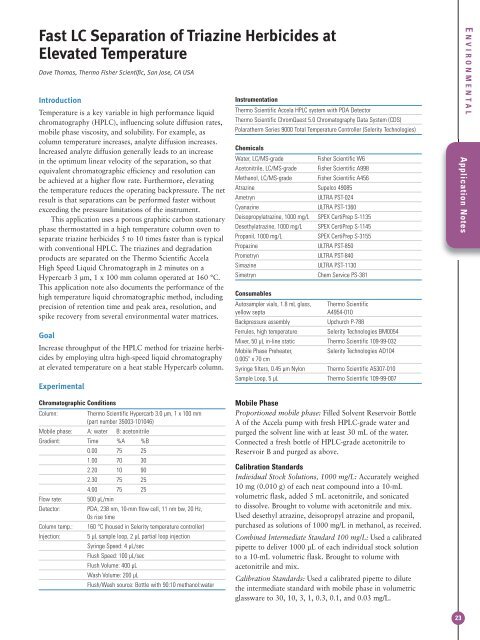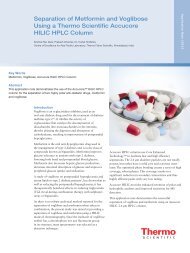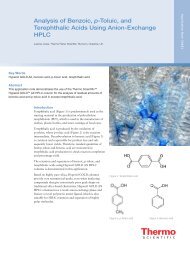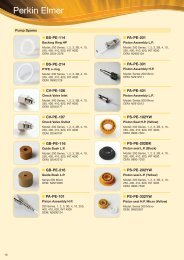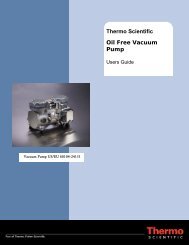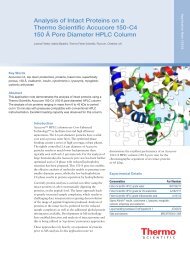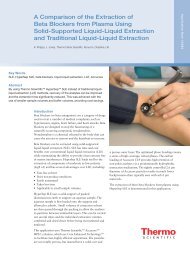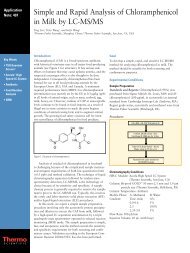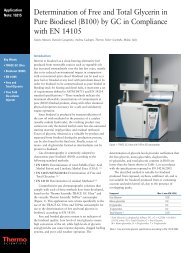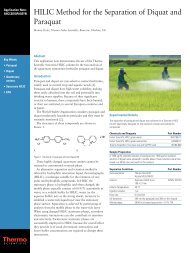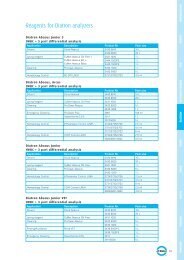Thermo Scientific Hypercarb Columns
Thermo Scientific Hypercarb Columns
Thermo Scientific Hypercarb Columns
You also want an ePaper? Increase the reach of your titles
YUMPU automatically turns print PDFs into web optimized ePapers that Google loves.
Fast LC Separation of Triazine Herbicides atElevated TemperatureDave Thomas, <strong>Thermo</strong> Fisher <strong>Scientific</strong>, San Jose, CA USAIntroductionTemperature is a key variable in high performance liquidchromatography (HPLC), influencing solute diffusion rates,mobile phase viscosity, and solubility. For example, ascolumn temperature increases, analyte diffusion increases.Increased analyte diffusion generally leads to an increasein the optimum linear velocity of the separation, so thatequivalent chromatographic efficiency and resolution canbe achieved at a higher flow rate. Furthermore, elevatingthe temperature reduces the operating backpressure. The netresult is that separations can be performed faster withoutexceeding the pressure limitations of the instrument.This application uses a porous graphitic carbon stationaryphase thermostatted in a high temperature column oven toseparate triazine herbicides 5 to 10 times faster than is typicalwith conventional HPLC. The triazines and degradationproducts are separated on the <strong>Thermo</strong> <strong>Scientific</strong> AccelaHigh Speed Liquid Chromatograph in 2 minutes on a<strong>Hypercarb</strong> 3 µm, 1 x 100 mm column operated at 160 °C.This application note also documents the performance of thehigh temperature liquid chromatographic method, includingprecision of retention time and peak area, resolution, andspike recovery from several environmental water matrices.GoalIncrease throughput of the HPLC method for triazine herbicidesby employing ultra high-speed liquid chromatographyat elevated temperature on a heat stable <strong>Hypercarb</strong> column.ExperimentalInstrumentation<strong>Thermo</strong> <strong>Scientific</strong> Accela HPLC system with PDA Detector<strong>Thermo</strong> <strong>Scientific</strong> ChromQuest 5.0 Chromatography Data System (CDS)Polaratherm Series 9000 Total Temperature Controller (Selerity Technologies)ChemicalsWater, LC/MS-gradeFisher <strong>Scientific</strong> W6Acetonitrile, LC/MS-grade Fisher <strong>Scientific</strong> A998Methanol, LC/MS-grade Fisher <strong>Scientific</strong> A456Atrazine Supelco 49085AmetrynULTRA PST-024CyanazineULTRA PST-1360Deisopropylatrazine, 1000 mg/L SPEX CertiPrep S-1135Desethylatrazine, 1000 mg/L SPEX CertiPrep S-1145Propanil, 1000 mg/L SPEX CertiPrep S-3155PropazineULTRA PST-850PrometrynULTRA PST-840SimazineULTRA PST-1130SimetrynChem Service PS-381ConsumablesAutosampler vials, 1.8 mL glass, <strong>Thermo</strong> <strong>Scientific</strong>yellow septa A4954-010Backpressure assembly Upchurch P-788Ferrules, high temperatureSelerity Technologies BM0054Mixer, 50 µL in-line static <strong>Thermo</strong> <strong>Scientific</strong> 109-99-032Mobile Phase Preheater,Selerity Technologies AD1040.005" x 70 cmSyringe filters, 0.45 µm Nylon <strong>Thermo</strong> <strong>Scientific</strong> A5307-010Sample Loop, 5 µL <strong>Thermo</strong> <strong>Scientific</strong> 109-99-007E NVIRONMENTALApplication NotesChromatographic ConditionsColumn:<strong>Thermo</strong> <strong>Scientific</strong> <strong>Hypercarb</strong> 3.0 µm, 1 x 100 mm(part number 35003-101046)Mobile phase: A: water B: acetonitrileGradient: Time %A %B0.00 75 251.00 70 302.20 10 902.30 75 254.00 75 25Flow rate: 500 µL/minDetector: PDA, 238 nm, 10-mm flow cell, 11 nm bw, 20 Hz,0s rise timeColumn temp.: 160 °C (housed in Selerity temperature controller)Injection: 5 µL sample loop, 2 µL partial loop injectionSyringe Speed: 4 µL/secFlush Speed: 100 µL/secFlush Volume: 400 µLWash Volume: 200 µLFlush/Wash source: Bottle with 90:10 methanol:waterMobile PhaseProportioned mobile phase: Filled Solvent Reservoir BottleA of the Accela pump with fresh HPLC-grade water andpurged the solvent line with at least 30 mL of the water.Connected a fresh bottle of HPLC-grade acetonitrile toReservoir B and purged as above.Calibration StandardsIndividual Stock Solutions, 1000 mg/L: Accurately weighed10 mg (0.010 g) of each neat compound into a 10-mLvolumetric flask, added 5 mL acetonitrile, and sonicatedto dissolve. Brought to volume with acetonitrile and mix.Used desethyl atrazine, deisopropyl atrazine and propanil,purchased as solutions of 1000 mg/L in methanol, as received.Combined Intermediate Standard 100 mg/L: Used a calibratedpipette to deliver 1000 µL of each individual stock solutionto a 10-mL volumetric flask. Brought to volume withacetonitrile and mix.Calibration Standards: Used a calibrated pipette to dilutethe intermediate standard with mobile phase in volumetricglassware to 30, 10, 3, 1, 0.3, 0.1, and 0.03 mg/L.23


